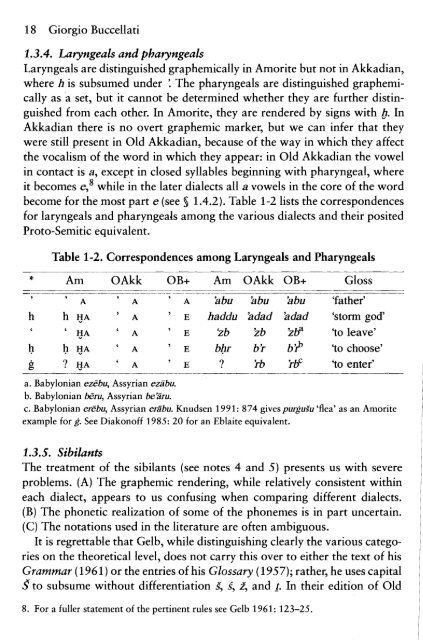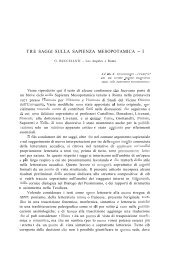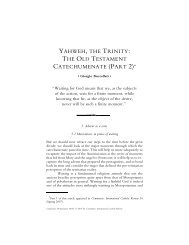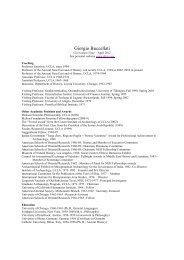Akkadian and Amorite Phonology
Akkadian and Amorite Phonology
Akkadian and Amorite Phonology
Create successful ePaper yourself
Turn your PDF publications into a flip-book with our unique Google optimized e-Paper software.
18 Giorgio Buccellati1.3.4. Laryngeals <strong>and</strong> pharyngealsLaryngeals are distinguished graphemically in <strong>Amorite</strong> but not in <strong>Akkadian</strong>,where h is subsumed under : The pharyngeals are distinguished graphemicallyas a set, but it cannot be determined whether they are further distinguishedfrom each other. In <strong>Amorite</strong>, they are rendered by signs with h. In<strong>Akkadian</strong> there is no overt graphemic marker, but we can infer that theywere still present in Old <strong>Akkadian</strong>, because of the way in which they affectthe vocalism of the word in which they appear: in Old <strong>Akkadian</strong> the vowelin contact is a, except in closed syllables beginning with pharyngeal, whereit becomes e,8 while in the later dialects all a vowels in the core of the wordbecome for the most part e (see $ 1.4.2). Table 1-2 lists the correspondencesfor laryngeals <strong>and</strong> pharyngeals among the various dialects <strong>and</strong> their positedProto-Semitic equivalent.Table 1-2. Correspondences among Laryngeals <strong>and</strong> Pharyngeals* Am OAkk OB+ Am OAkk OB+ Gloss-- ---. -.--.- - - --- --- -- -- -- ---- --- -- - - --- -- .-A A ' A 'abu 'abu 'abu 'father'h h 5 ~ ' A ' E haddu 'adad 'adad 'storm god'' E ~ A ' A ' E 'zb 'zb 'zba 'to leave'~ E J A ' A E bhr b'r b$ Yo choose'g ? g ~ ' A E ? 'rb kbC 'to enter'-. -- -- --------.-- - --.--- --- - -- -- -- -- -- -a. Babylonian ezGbu, Assyrian eziibu.b. Babylonian kru, Assyrian besru.c. Babylonian erebu, Assyrian eHbu. Knudsen 1991: 874 givespurgugu 'flea' as an <strong>Amorite</strong>example for g. See D~akonoff 1985: 20 for an Eblaite equivalent.1.3.5. SibilantsThe treatment of the sibilants (see notes 4 <strong>and</strong> 5) presents us with severeproblems. (A) The graphemic rendering, while relatively consistent withineach dialect, appears to us confusing when comparing different dialects.(B) The phonetic realization of some of the phonemes is in part uncertain.(C) The notations used in the literature are often ambiguous.It is regrettable that Gelb, while distinguishing clearly the various categorieson the theoretical level, does not carry this over to either the text of hisGrammar (1961) or the entries of his Glossary (1957); rather, he uses capitalto subsume without differentiation 3, i, 2, <strong>and</strong> 1. In their edition of Old8. For a fuller statement of the pertinent rules see Gelb 1961: 123-25.







